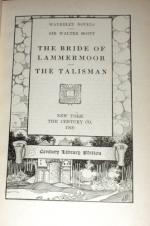When Dick Tinto had thus spoken, he rummaged his portfolio for the sketch from which he proposed one day to execute a picture of fourteen feet by eight. The sketch, which was cleverly executed, to use the appropriate phrase, represented an ancient hall, fitted up and furnished in what we now call the taste of Queen Elizabeth’s age. The light, admitted from the upper part of a high casement, fell upon a female figure of exquisite beauty, who, in an attitude of speechless terror, appeared to watch the issue of a debate betwixt two other persons. The one was a young man, in the Vandyke dress common to the time of Charles I., who, with an air of indignant pride, testified by the manner in which he raised his head and extended his arm, seemed to be urging a claim of right, rather than of favour, to a lady whose age, and some resemblance in their features, pointed her out as the mother of the younger female, and who appeared to listen with a mixture of displeasure and impatience.
Tinto produced his sketch with an air of mysterious triumph, and gazed on it as a fond parent looks upon a hopeful child, while he anticipates the future figure he is to make in the world, and the height to which he will raise the honour of his family. He held it at arm’s length from me—he helt it closer—he placed it upon the top of a chest of drawers—closed the lower shutters of the casement, to adjust a downward and favourable light—fell back to the due distance, dragging me after him—shaded his face with his hand, as if to exclude all but the favourite object—and ended by spoiling a child’s copy-book, which he rolled up so as to serve for the darkened tube of an amateur. I fancy my expressions of enthusiasm had not been in proportion to his own, for he presently exclaimed with vehemence: “Mr. Pattieson, I used to think you had an eye in your head.”
I vindicated my claim to the usual allowance of visual organs.
“Yet, on my honour,” said Dick, “I would swear you had been born blind, since you have failed at the first glance to discover the subject and meaning of that sketch. I do not mean to praise my own performance, I leave these arts to others; I am sensible of my deficiencies, conscious that my drawing and colouring may be improved by the time I intend to dedicate to the art. But the conception—the expression—the positions—these tell the story to every one who looks at the sketch; and if I can finish the picture without diminution of the original conception, the name of Tinto shall no more be smothered by the mists of envy and intrigue.”
I replied: “That I admired the sketch exceedingly; but that to understand its full merit, I felt it absolutely necessary to be informed of the subject.”
“That is the very thing I complain of,” answered Tinto; “you have accustomed yourself so much to these creeping twilight details of yours, that you are become incapable of receiving that instant and vivid flash of conviction which darts on the mind from seeing the happy and expressive combinations of a single scene, and which gathers from the position, attitude, and countenance of the moment, not only the history of the past lives of the personages represented, and the nature of the business on which they are immediately engaged, but lifts even the veil of futurity, and affords a shrewd guess at their future fortunes.”




